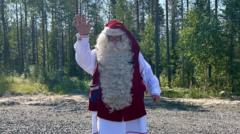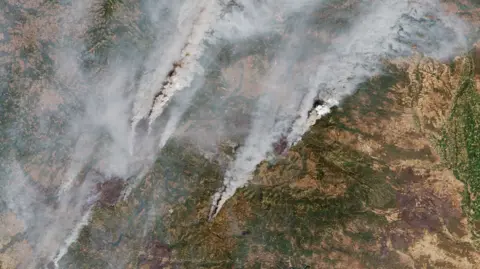Lapland’s famed Santa Claus is facing an unexpected challenge this summer as northern Finland grapples with an unprecedented heatwave, pushing temperatures to record levels. "Make sure the reindeer have enough water," Santa advised his workshop helpers, underscoring the absurdity of discussing sun safety in a region known for its cold winters. Rovaniemi, Santa's hometown, is sweltering as daily highs hover around a blistering 30°C, forcing the jolly figure to retreat indoors throughout the day, donning his heavy-red fur-trimmed attire only for late evening swims.
“It's shocking to see Lapland, typically associated with snow and ice, experiencing such heat,” Santra remarked, reflecting a growing concern among residents and climate scientists alike. This year’s heatwave, lasting an astonishing 15 days up to July 25, breaks previous records and highlights a concerning trend in the Arctic region, where summer temperatures are soaring due to climate change. Finnish Meteorological Institute’s Jaakko Savela noted, “The last similarly prolonged heatwave occurred in 1972, clocking in at 12 to 14 days. We’ve now shattered that record.”
The ramifications extend beyond the whimsical narrative of Santa’s workshop; various weather stations across Lapland have noted extraordinary heatwaves, with the highest readings peaking at 31.7°C. Such spikes are not typical for Lapland, which usually enjoys a summer temperature closer to 20°C. Though Savela affirms that climate change didn't directly cause this specific heat event, he concedes that the extreme conditions have been exacerbated by long-term warming trends.
Prof. Jeff Weller from the University of Oulu stated that intense heatwaves are increasingly common, emphasizing that climate change fundamentally alters our weather systems. “Every day, we see the fingerprints of climate change in severe weather patterns,” he explained, noting UN findings that predict hotter summers may become the new norm.
For reindeer, who represent a cultural staple in the Arctic during the holiday season, the soaring temperatures pose significant challenges. The animals are seen fleeing their natural habitats, driven by swarms of mosquitoes flourishing under heat, seeking refuge in populated areas for relief. Weller also raised concerns about the future adaptability of reindeer herding practices, suggesting herders may need to construct shelters for their animals against rising heat.
Tourists visiting Santa’s village are equally disillusioned, with many venturing to Lapland seeking a break from sweltering climates elsewhere. “I expected cooler weather; I only packed t-shirts,” lamented Silvia from Prague while trying to enjoy her visit amidst the 30°C warmth. Others shared similar feelings of confusion, noting the disparity between their expectations and the reality present in a traditionally frosty tourist destination.
As the days stretch long with nearly 20 hours of sunlight, Santa and his workforce find themselves confronting an unusual reality, with thoughts of climate change looming over their holiday preparations. “A hot summer can be pleasant, but I favor the cold,” mused Santa, indicating a clear longing for the comforting chill of winter that has defined his entire existence. As concerns grow about shifting weather patterns, the future of Lapland’s winters remains a topic of dialogue among locals and visitors alike. “I’m left wondering if such heatwaves are now our reality,” said elf Elina, encapsulating the looming anxiety prevalent among the Arctic's inhabitants.
“It's shocking to see Lapland, typically associated with snow and ice, experiencing such heat,” Santra remarked, reflecting a growing concern among residents and climate scientists alike. This year’s heatwave, lasting an astonishing 15 days up to July 25, breaks previous records and highlights a concerning trend in the Arctic region, where summer temperatures are soaring due to climate change. Finnish Meteorological Institute’s Jaakko Savela noted, “The last similarly prolonged heatwave occurred in 1972, clocking in at 12 to 14 days. We’ve now shattered that record.”
The ramifications extend beyond the whimsical narrative of Santa’s workshop; various weather stations across Lapland have noted extraordinary heatwaves, with the highest readings peaking at 31.7°C. Such spikes are not typical for Lapland, which usually enjoys a summer temperature closer to 20°C. Though Savela affirms that climate change didn't directly cause this specific heat event, he concedes that the extreme conditions have been exacerbated by long-term warming trends.
Prof. Jeff Weller from the University of Oulu stated that intense heatwaves are increasingly common, emphasizing that climate change fundamentally alters our weather systems. “Every day, we see the fingerprints of climate change in severe weather patterns,” he explained, noting UN findings that predict hotter summers may become the new norm.
For reindeer, who represent a cultural staple in the Arctic during the holiday season, the soaring temperatures pose significant challenges. The animals are seen fleeing their natural habitats, driven by swarms of mosquitoes flourishing under heat, seeking refuge in populated areas for relief. Weller also raised concerns about the future adaptability of reindeer herding practices, suggesting herders may need to construct shelters for their animals against rising heat.
Tourists visiting Santa’s village are equally disillusioned, with many venturing to Lapland seeking a break from sweltering climates elsewhere. “I expected cooler weather; I only packed t-shirts,” lamented Silvia from Prague while trying to enjoy her visit amidst the 30°C warmth. Others shared similar feelings of confusion, noting the disparity between their expectations and the reality present in a traditionally frosty tourist destination.
As the days stretch long with nearly 20 hours of sunlight, Santa and his workforce find themselves confronting an unusual reality, with thoughts of climate change looming over their holiday preparations. “A hot summer can be pleasant, but I favor the cold,” mused Santa, indicating a clear longing for the comforting chill of winter that has defined his entire existence. As concerns grow about shifting weather patterns, the future of Lapland’s winters remains a topic of dialogue among locals and visitors alike. “I’m left wondering if such heatwaves are now our reality,” said elf Elina, encapsulating the looming anxiety prevalent among the Arctic's inhabitants.

















